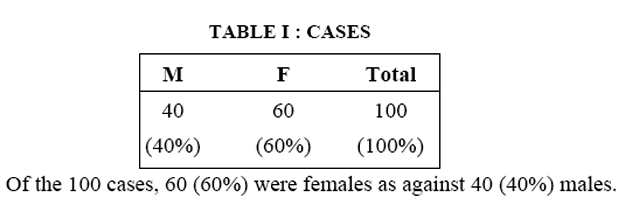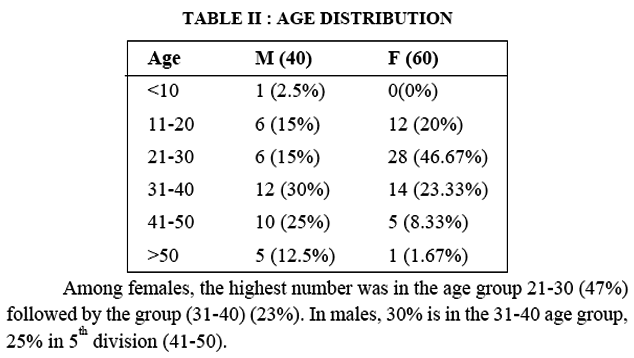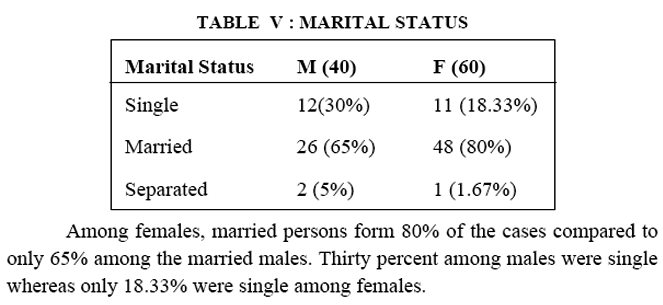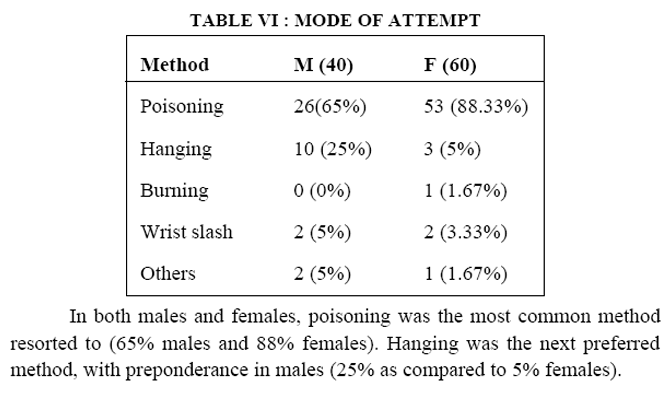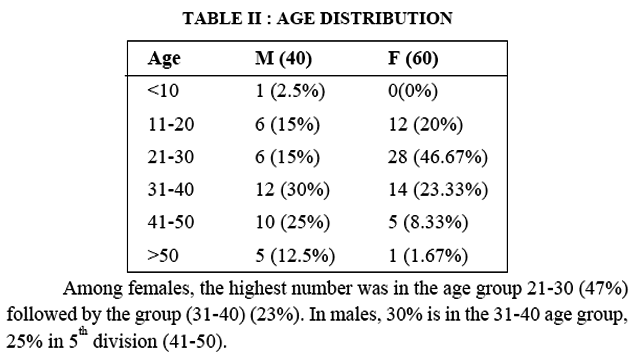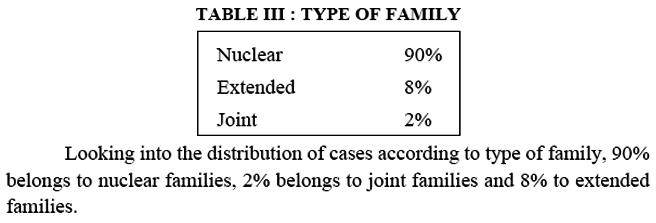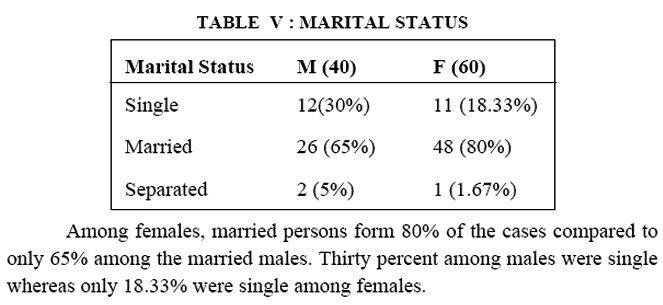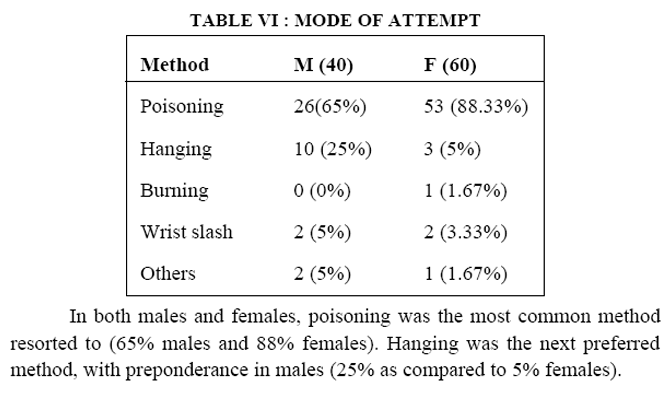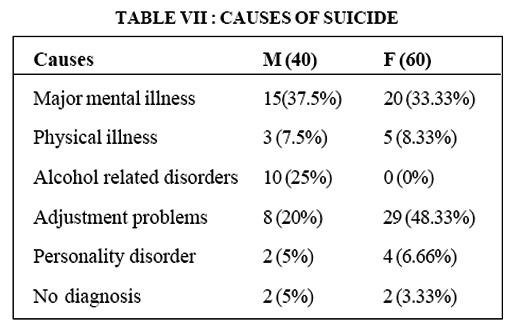Abstract: The term “mental health” is a misnomer since we cannot separate mental and physical health and confine them to watertight compartments. There can only be one state of health which has both mental and physical aspects. Hence “health” has been defined as a positive sense of well-being – physical, mental and social and not merely absence of illness. Mental health signifies the capacity of an individual to form harmonious relationship with others and to participate in or contribute constructively to changes in social environment. The subjective well being, human behaviour and the diseases that occur, can be explained by a “biopsycho-social model.” Differences in the health issues of the two sexes can be explained by the differences in the interplay of the biological, psychological and social factors.
Keywords: psychiatric morbidity, psychological distress, support system associations, adjustment problems, suicide prevention, increase mental health issues
”If you want to know more about femininity, enquire from your own experiences of life or turn to the poets or wait until science can give you deeper and more coherent information” (Sigmund Freud 1933). The far-reaching differences between men and women have inspired curiosity, poetry and romance for centuries but only recently have they been the subject of scrutiny by medical and social scientists.
The term “mental health” is a misnomer since we cannot separate mental and physical health and confine them to watertight compartments. There can only be one state of health which has both mental and physical aspects. Hence “health” has been defined as a positive sense of well being – physical, mental and social and not merely absence of illness (WHO). Expert Committee of WHO defines Mental Health “as the capacity of an individual to form harmonious relationship with others and to participate in or contribute constructively to change in social environment”. It is in essence relationship with oneself, with one’s environment and thus the development of mature, well adjusted personalities. The subjective well being, human behavior and the diseases that occur, all can be explained by a “biopsycho-social model”. (George Engel 1980). The biological system emphasizes the anatomical, structural and molecular substratum and its impact on a person’s biological functioning. The psychological system emphasizes the impact of psychodynamic factors and personality; the social system includes the cultural, environmental and familial influences. Differences in the health issues of the two sexes can be explained by the differences in the interplay of these factors.
Of the 10-20/1000 of the general population in any one year presented as a psychiatric case, about a third can be classified as new cases. (WHO 1973,1990). The percentage is much higher, almost 10 times in medical outpatients as shown in studies by different workers (Hawkins, Oktang, Shephered, Finn & Huston, Goldberg). Most of these studies have also shown that hidden psychiatric morbidity is more in women especially in the age group of 35-54 yrs. As per the WHO collaborative study on strategies for extending mental health care in developing countries including India, the recorded frequency of mental morbidity ranged from 10-6 – 17-7%, with an estimated prevalence of severe mental disorders at around 1-2% in India (Harding et al 1980, M.N.Wig 1984). Majority of this morbidity is “minor” and non-psychic. Minor non psychotic morbidity is present as non specific somatic complaints, especially in women (Bagadia et al 1986, Sen 1987). Non specific somatic symptoms are an early mode of communication of psychological distress.
From India, it has been repeatedly reported that a higher percentage of male population register at the psychiatric facilities (Sethi B.B., Neki J.G, Kapoor R.K). Women tend to have more frequent illness and disability but the problems are typically not serious or life threatening. In contrast men suffer from more life threatening illness and these cause more permanent disability and earlier death.
Let us look into the various factors operating in women.
1. Biological Risk
The reproductive events of pregnancy, child birth and menstruation give women a unique morbidity not experienced by men. Several studies have found that post-partum period is a time of greater risk for depression and their aetiology may well be biological (hormonal). The incidence of post partum psychosis and psychotic breakdown in the first month after delivery is very high, again postulating hormonal imbalances. Menstruation is a biological event. Emotional and behaviorial changes occuring during menstrual cycle and at the time of menopause are also evidences denoting biological factors causing changes in women.
2. Acquired Risk
The most popular explanation offered for greater female distress concerns women’s social roles in traditional cultures. The role of a housewife played by married women is relatively unskilled, boring and low in status. The role is invisible, unstructured and allows her to brood and become involved in personal problems in a way that working women in a more structured role cannot. The “daily hassles” of a house-wife may have a cumulative effect. Working women, on the other hand, are believed to have excessive demands on their time and attention; performing multiple roles in life including that of a wife, mother, employee, and caretaker of elderly relatives, constantly engaged in maintaining family ties. Contemporary women thus have more stressed lives than men, no matter what they do. Researchers have pointed out that even among professional women who perceive their careers to be as salient or integral to their lives as their spouses, family interests superseded career concerns. (Hardesty & Betz 1980). In an Indian study of 120 women, it was found that personal events contributed towards greater stress in married women (Avinash Virk 1990). Work appeared to have a protective effect but to a small extent. In India higher morbidity in married women as compared to single, divorced, or widowed has been observed. (Dube K.C., Sethi B.B, Vargheese.A). Among the married, housewives are prone to develop neurotic disorders (Sethi B.B, Gupta S.C).
In a community study, Brown & Harris (1984) described four vulnerability factors which increased the chances of a woman developing stress in the form of depression. They are:
1) Lack of confiding relationship 2) Lack of employment outside home 3) Presence of 3 or more children under 14 years at home 4) Parental loss before 17 yrs of age.
Contrary to the notion that executive jobs produce high stress, heart disease is more common among women in clerical or low status jobs. In an 8 year prospective study, clerical workers who reported having an unsupportive boss were at increased risk of developing coronary artery disease when other variables were controlled (Eaker 1989). This reflects on the role of support system available. The spontaneous support system available in a joint family is disintegrating now (Sharma et al 1999). In this situation, the Indian women who provide the most basic joining bond have also undergone tremendous change. The women have come forward to earn their livelihood and hence the strong bonds developing out of dependence have been eroded, resulting in family conflicts and marital maladjustment (Kaul, Sinha 1981). The degree of unity in a family, unity in decision-making and financial togetherness was found to have an inverse relationship with neurotic manifestations in females (Agarwal et al 1991).
Women tend to be less delighted about life than men and this may make them more vulnerable to stress related illnesses, but women also buffet them by reacting to disturbing situations in more benign ways. They turn to other people and to medical drugs for relief whereas men opt for quiet brooding or resort to alcohol, cigarettes or drugs. Over their life time women maintain stronger emotional ties with a greater number of people. Intimate ties with friends offer support and thus deter loneliness.
Women are more sensitive to bodily discomforts. This may be because of childhood socialisation – boys are discouraged from complaining about bumps and bruises while more attention is given to body awareness that menstruation provokes in girls. Thus women are more apt to label their symptoms as physical illness. On the other hand, it is thought not “masculine” to be ill and men ignore minor symptoms. Thus women tend to somatise their distress, the process by which psychological distress is channelised to physical symptoms, among which the commonest presentation is chronic pain syndromes (Venkoba Rao, Nandi, Neki, Wig).
Women adopt a sick role more often than men. They have more dependent help-seeking behaviour and trust in authority. They believe that bed rest, activity restriction, compassion from others and medical attention are helpful. Women also adopt more preventive health practices.
The difference between the two sexes is also reflected in the cultural belief systems. Women adhere to these belief systems and religious practices more often than men. Religious beliefs reduce our existential insecurity. Religious practices and rituals have a possible function of reducing anxiety and giving the person hope for the future. Religious practices clearly serve as a release mechanism for pent up emotions. Festivals and other celebrations instil a feeling of togetherness and serve to raise depressed spirits. The theory of rebirth which is believed at least by the Hindus, gives an explanation for present sufferings and an ability to withstand them, though excessive or mal-adaptive pattern make them inactive as well.
In many parts of the world which are not scientifically and technologically advanced, the concept of mental illness is influenced by belief systems. One such condition commonly reported in Indian villages, especially in middle aged women, is possession states. The woman behaves as though she is possessed by gods, evil spirits or spirits of dead persons. She shouts, blesses, curses, prophesies at random and speaks with indisputable authority commanding respect from all around her. Thus, this is an opportunity for emotional release in a socially sanctioned way.
The manifestations as well as the response patterns of psychological problems vary between the sexes. Whereas the response to serious or life-threatening illness is of a uniform pattern in terms of hospitalisation and medical care, the minor psychiatric morbidity seen more often in women offers a variety of responses. This may be in the form of assuming a sick role and enjoying it, talking about the problems to friends and neighbours, turning to faith-healers and traditional health care systems, visiting religious places or seeking professional help. This explains and agrees with the study results repeatedly reported from India that higher percentage of male population registers and avails psychiatric facilities (Sethi B.B, Neki. J.S, Kapoor R.K). Persons who face stress and psychiatric problems of sex find solace in suicide and attempt it.
Suicide and Attempted Suicide
Suicidal behavior is a major public health issue in all the countries. According to Crime Records Bureau, suicide is among the top ten causes of death and in the age group of 16-35 years suicide is among the top three causes of death. Suicide rate in India shows a steady rise in recent years. The national figure rose from 6.8/lakh population in 1988 to 8.5/lakh in 1990(Govt. of India 1990). The current figure is 11.2/lakh population (Govt. of India 1999, IASP, Chennai 2001). The southern states have higher suicide rates than northern states. Kerala ranks first in suicide rate in India (32/lakh).
India accounts for 10% of world suicide. There is one successful suicide every six minutes. For every one successful attempt, there are at least ten unsuccessful cases. Men commit suicide more than three times as often as women. But women on the other hand are three times as likely to attempt suicide as men.
International report on suicide rates consistently identify major differences in the gender ratio between Western and Asian countries; the male to female ratio in western countries is typically 3:1 or higher, while in most Asian countries the ratio is closer to 1:1. (Data based on publication of abstracts at the International conference of IASP– International Association for Suicide Prevention, Chennai, Sept.2001).
Attempted suicide is a non-habitual act with a nonfatal outcome that is deliberately initiated and performed by the individual. Stengel (1952) described the act of attempted suicide as “calling forth action from the human environment”. Hence this behavior has been referred to as an “appeal character”, an alarm signal or a cry for help. Follow up studies revealed that 13-30% of attempters will repeat the act within two years (Resuik 1980). Most of those who attempt suicide lack a genuine self-destructive intention and do not seek death. Instead, what they seek is amelioration of their psychological distress, largely originating from environmental stresses. Vulnerability factors described include high intra family stress, physical abuse or severing of a relationship with a key family figure (Pfeffer C.R 1988, ICMR 1998, Venkoba Rao & Madhavan 1983). Among the intra family stresses, marital problems contribute to a major extent. Alcohol abuse of spouse contributed to 30-40% attempted suicides. Changing value system and breakdown of traditional support system seem to play a crucial role in the high incidence of suicide.
Even under the most adverse and painful circumstances man clings to life, be it just for hours or even minutes. Hence suicide and suicidal attempts look extremely paradoxical. Thus looking into some of the factors in the suicidal attempts gives a better insight about the psychological state of the individual. Data analysis of 100 cases of suicidal attempters that came to the notice of the Suicide Prevention Clinic of Medical College, Thiruvananthapuram was done with this in mind and the gender wise differences in the findings are discussed hereunder.
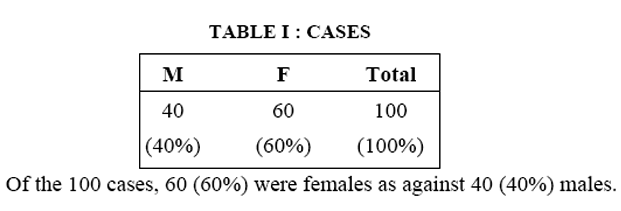 |
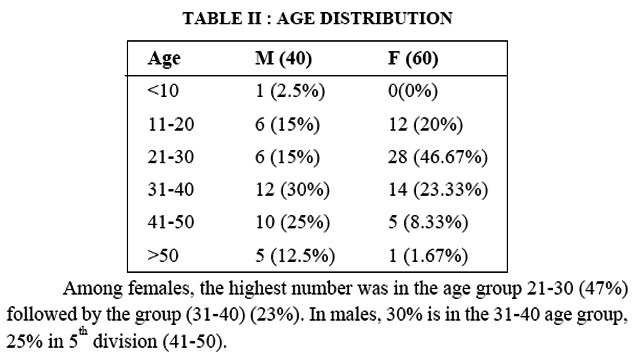 |
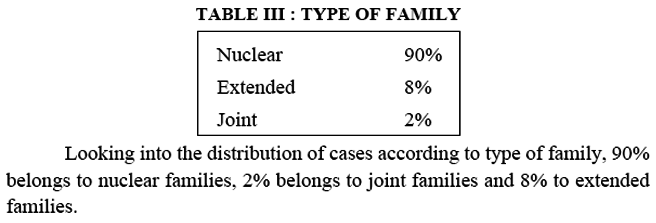 |
 |
 |
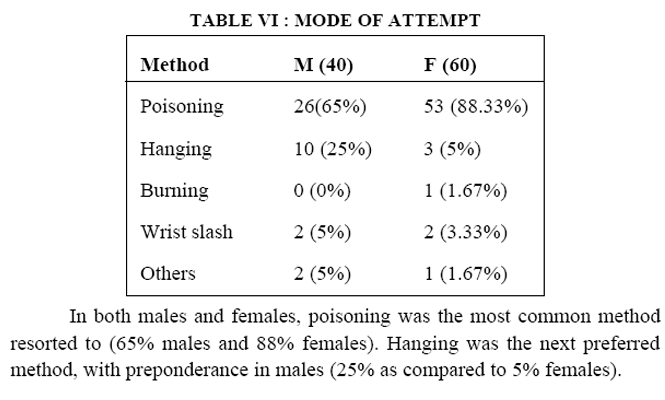 |
 |
Distribution of patients according to causes shows that adjustment problem was predominant in females (48.33%) whereas major mental illness shows an almost even distribution among both sexes (37.5% in males & 33.33% in females). Alcohol related disorders contribute to 25% of males and nil among females. A significant factor that contributed to the attempt in females was the adjustment problem (29 cases, 48%). Hence this group is further analysed to find out the type of adjustment involved. Marital problems, in one form or another, were the most probable causes in more than half the cases (17 cases, 58.6%). The marital conflicts were alcoholic husband and wife beating (14 cases, 82.3%) and extramarital relationship of spouse (3 cases, 17.6%). Interpersonal adjustment problems with in – laws, parents and siblings were linked with the act in 4 cases. Financial crisis (3 cases) unemployment (1 case) failed love affair (1 case) failure in examination (2 cases) were the other reasons elicited.
Results of the Analysis
1. Females predominated over males.
2. More number of attempts occur in women at younger age groups.
3. Majority of attempters are from nuclear families
4. Married persons form the major group.
5. Commonest method is poisoning. Lethal methods like hanging are also adopted, more by males.
6. Major mental illness and alcohol related disorders contribute to more than half the cases in males.
7. Adjustment problems emerged as a major cause in females.
8. Marital conflicts were in the forefront, in which alcoholism in husband is a major factor followed by other inter-personal adjustment problems.
9. Alcohol does play a major role in these attempters either directly or indirectly.
Females in India are submissive, docile and non assertive and these traits have been built into their psyche with the result that they find themselves unable to deal with their negative feelings adequately. Among the hostile environment of the families with problems of a difficult husband, they feel helpless.
The inbuilt suicide “counters” of cultural, religious, family and economic nature inhibit the suicide-wish temporarily. When the “Reasons for dying” predominates over “Reasons for living”, the attempt occurs as a way out from psychological pain and suffering. This calls for measures to cultivate and improve their coping styles to face various conflicts, utilising the support system available.
REFERENCES:
Agarwal et al “A Study of Psychiatric Morbidity in Gynaecology Out patient Clinic”. Indian Journal of Psychiatry, 32.1.1990: 57-63.
Agarwal et al. “Overview of Psychiatric Research in India (1973-1992)” th Souvenir of the 46 Annual National Conference of Indian Psychiatric Society, 6-9 January 1994, Chennai, 1994: 1-15.
Abstracts of Scientific Papers, XXI Congress of the International Association for Suicide Prevention, Chennai, India 22-26 Sept. 2001.
Bagadia et al. “Psychiatric Morbidity among Patients Attending Medical Out Patient Department”. Indian Journal of Psychiatry, 28.1986: 139-144.
Brown & Harris. Social Origins of Depression. A Study of Psychiatric Disorder in Women. London: Tavistock, 1984.
Dube K.C. “A Study of Prevalence and Biosocial Variables in Mental illness in a Rural and Urban Community”, Acta Psychiatric Scand, 46.1970: 327-332.
Engel G.L. “The Clinical Application of the Bio-psycho Social Model”. American Journal of Psychiatry. 137.1980: 535.
Eaker, ed. “Psychosocial Factors in the Epidemiology of Coronary Heart Disease in Women”. Psychiatric Clinics of North America, 12.1989: 167-173.
Frend.S. “Feminity”, Complete Psychological Works, Standard Edition Vol. 22 (ed. & Trans: by T. Strachey)
London : Hogarth Press.,1933: 112-135. Goldberg D.P. “Psychiatric Illness in General Practice”. British Medical Journal, 2.1970: 439-443.
Government of India. Accidental Deaths and Suicide in India, National Crime Records Bureau, Ministry of House Affairs, Govt.of India, New Delhi., 1988, 1999, 2000.
Harding et al . “Mental Disorders in Primary Care”. Psychological Medicine, 10. 1980: 231-241.
Hardesty & Betz, . “The Relationships of Career Salience, Attitudes Towards Women”. Journal of Vocational Behaviour 17.1980: 242-250.
Indian Council of Medical Research Report of the Multi Center Collaborative Study on Severe Mental Morbidity, Bangalore: NIMHNS., 1983.
Indian Council of Medical Research. Final Report on “A Study of Suicide Behavior”.1988.
Kreitman. N : “Suicide and Para Suicide”, Companion to Psychiatric Studies, ed. Churchil Livingstone, Edinburgh. 4.1988: 459-475.
Kapur R.L. “Mental Health Care in Rural India”. British Journal of Psychiatry, 127.1975: 283-93.
D.N. Nandi, et al . “A Study of Psychiatric Morbidity of a Rural Community at an Interval of 10 years”. India Journal of Psychiatry, 283.1986: 179- 194.
Neki J.S. “An Examination of Cultural Relativism of Dependence as a Dynamics of Social and Therapeutic Relationship”. British Journal of Medical Psychology 49.1976: 1-10.
Pfeffer C.R. “Suicidal Behavior among Children and Adolescents”. Review of Psychiatry, 7.1988: 386-402.
Sen.B. “Psychiatric Phenomena in Primary Health Care”. Indian Journal of Psychiatry, 29.1987: 33-40.
Sethi B.B, Gupta S.C. “A Psychiatric Survey of 500 Rural Families”, Indian Journal of Psychiatry, 14.1972: 183-188.
Sethi B.B. and Sharma M. “Social Interaction and Family Patterns in Rural and Urban Community”. Indian Journal of Social Psychiatry, 1.1985:66-74.
Sethi B.B. “Family as a Potent Therapeutic Force”. Indian Journal of Psychiatry, 31.1.1989: 22-30.
Sephered, M. Psychiatric Illness in General Practice, Oxford : Oxford University Press, 1966. Stengel. Suicide and Attempted Suicide Review. Great Britain: Penguin Books, 1970.
L.Vijayakumar, 2001 Founder Member (since 1980). “Sneha”, Non Governmental Organization for the Prevention of Suicide, Madras (Ref : No: 3).
Rao, A.Venkoba et al. “A Study in Suicidology”. Indian Journal of Psychiatry, 31.1. 1989: 43-50.
————. Socio-cultural factors of Marriage and Suicide Behavior in India th with Special Reference to Dowry Death. In : Proceedings of 20 Annual
Conference AAS & IASP, Sanfransisco, USA (Eds) Robert I Yufit. 1987. Rao, A.Venkoba and Madhavan.Suicide in Asia and near East, London: University of California Press, 1983.
Virk.A. “Women, Marriage and Work – A Study of Relative Role of Stress, Social Support and Mental Health”. M.D Thesis, Punjab University, Patiala, India, 1990.
Wig, N.N. Psychiatric Research in India Mumbai: Bhalani Book Depot, 1984: 703-771.
World Health Organization. Figures and Facts about Suicide, Geneva: Department of Mental Health, WHO, 1999.
Contributor
N. SUBHA. Is Assistant Professor of Psychiatry at the Medical College Hospital, Thiruvananthapuram. Her areas of interest are Postpartum psychiatric disorders and psychopharmacology. She has contributed to research journals. She is involved in an ongoing research on alcohol related disorders.
WOMEN AND MENTAL HEALTH
N. SUBHA
Abstract: The term “mental health” is a misnomer since we cannot separate mental and physical health and confine them to watertight compartments. There can only be one state of health which has both mental and physical aspects. Hence “health” has been defined as a positive sense of well-being – physical, mental and social and not merely absence of illness. Mental health signifies the capacity of an individual to form harmonious relationship with others and to participate in or contribute constructively to changes in social environment. The subjective well being, human behaviour and the diseases that occur, can be explained by a “biopsycho-social model.” Differences in the health issues of the two sexes can be explained by the differences in the interplay of the biological, psychological and social factors.
Keywords: psychiatric morbidity, psychological distress, support system associations, adjustment problems, suicide prevention, increase mental health issues
”If you want to know more about femininity, enquire from your own experiences of life or turn to the poets or wait until science can give you deeper and more coherent information” (Sigmund Freud 1933). The far-reaching differences between men and women have inspired curiosity, poetry and romance for centuries but only recently have they been the subject of scrutiny by medical and social scientists.
The term “mental health” is a misnomer since we cannot separate mental and physical health and confine them to watertight compartments. There can only be one state of health which has both mental and physical aspects. Hence “health” has been defined as a positive sense of well being – physical, mental and social and not merely absence of illness (WHO). Expert Committee of WHO defines Mental Health “as the capacity of an individual to form harmonious relationship with others and to participate in or contribute constructively to change in social environment”. It is in essence relationship with oneself, with one’s environment and thus the development of mature, well adjusted personalities. The subjective well being, human behavior and the diseases that occur, all can be explained by a “biopsycho-social model”. (George Engel 1980). The biological system emphasizes the anatomical, structural and molecular substratum and its impact on a person’s biological functioning. The psychological system emphasizes the impact of psychodynamic factors and personality; the social system includes the cultural, environmental and familial influences. Differences in the health issues of the two sexes can be explained by the differences in the interplay of these factors.
Of the 10-20/1000 of the general population in any one year presented as a psychiatric case, about a third can be classified as new cases. (WHO 1973,1990). The percentage is much higher, almost 10 times in medical outpatients as shown in studies by different workers (Hawkins, Oktang, Shephered, Finn & Huston, Goldberg). Most of these studies have also shown that hidden psychiatric morbidity is more in women especially in the age group of 35-54 yrs. As per the WHO collaborative study on strategies for extending mental health care in developing countries including India, the recorded frequency of mental morbidity ranged from 10-6 – 17-7%, with an estimated prevalence of severe mental disorders at around 1-2% in India (Harding et al 1980, M.N.Wig 1984). Majority of this morbidity is “minor” and non-psychic. Minor non psychotic morbidity is present as non specific somatic complaints, especially in women (Bagadia et al 1986, Sen 1987). Non specific somatic symptoms are an early mode of communication of psychological distress.
From India, it has been repeatedly reported that a higher percentage of male population register at the psychiatric facilities (Sethi B.B., Neki J.G, Kapoor R.K). Women tend to have more frequent illness and disability but the problems are typically not serious or life threatening. In contrast men suffer from more life threatening illness and these cause more permanent disability and earlier death.
Let us look into the various factors operating in women.
1. Biological Risk
The reproductive events of pregnancy, child birth and menstruation give women a unique morbidity not experienced by men. Several studies have found that post-partum period is a time of greater risk for depression and their aetiology may well be biological (hormonal). The incidence of post partum psychosis and psychotic breakdown in the first month after delivery is very high, again postulating hormonal imbalances. Menstruation is a biological event. Emotional and behaviorial changes occuring during menstrual cycle and at the time of menopause are also evidences denoting biological factors causing changes in women.
2. Acquired Risk
The most popular explanation offered for greater female distress concerns women’s social roles in traditional cultures. The role of a housewife played by married women is relatively unskilled, boring and low in status. The role is invisible, unstructured and allows her to brood and become involved in personal problems in a way that working women in a more structured role cannot. The “daily hassles” of a house-wife may have a cumulative effect. Working women, on the other hand, are believed to have excessive demands on their time and attention; performing multiple roles in life including that of a wife, mother, employee, and caretaker of elderly relatives, constantly engaged in maintaining family ties. Contemporary women thus have more stressed lives than men, no matter what they do. Researchers have pointed out that even among professional women who perceive their careers to be as salient or integral to their lives as their spouses, family interests superseded career concerns. (Hardesty & Betz 1980). In an Indian study of 120 women, it was found that personal events contributed towards greater stress in married women (Avinash Virk 1990). Work appeared to have a protective effect but to a small extent. In India higher morbidity in married women as compared to single, divorced, or widowed has been observed. (Dube K.C., Sethi B.B, Vargheese.A). Among the married, housewives are prone to develop neurotic disorders (Sethi B.B, Gupta S.C).
In a community study, Brown & Harris (1984) described four vulnerability factors which increased the chances of a woman developing stress in the form of depression. They are:
1) Lack of confiding relationship 2) Lack of employment outside home 3) Presence of 3 or more children under 14 years at home 4) Parental loss before 17 yrs of age.
Contrary to the notion that executive jobs produce high stress, heart disease is more common among women in clerical or low status jobs. In an 8 year prospective study, clerical workers who reported having an unsupportive boss were at increased risk of developing coronary artery disease when other variables were controlled (Eaker 1989). This reflects on the role of support system available. The spontaneous support system available in a joint family is disintegrating now (Sharma et al 1999). In this situation, the Indian women who provide the most basic joining bond have also undergone tremendous change. The women have come forward to earn their livelihood and hence the strong bonds developing out of dependence have been eroded, resulting in family conflicts and marital maladjustment (Kaul, Sinha 1981). The degree of unity in a family, unity in decision-making and financial togetherness was found to have an inverse relationship with neurotic manifestations in females (Agarwal et al 1991).
Women tend to be less delighted about life than men and this may make them more vulnerable to stress related illnesses, but women also buffet them by reacting to disturbing situations in more benign ways. They turn to other people and to medical drugs for relief whereas men opt for quiet brooding or resort to alcohol, cigarettes or drugs. Over their life time women maintain stronger emotional ties with a greater number of people. Intimate ties with friends offer support and thus deter loneliness.
Women are more sensitive to bodily discomforts. This may be because of childhood socialisation – boys are discouraged from complaining about bumps and bruises while more attention is given to body awareness that menstruation provokes in girls. Thus women are more apt to label their symptoms as physical illness. On the other hand, it is thought not “masculine” to be ill and men ignore minor symptoms. Thus women tend to somatise their distress, the process by which psychological distress is channelised to physical symptoms, among which the commonest presentation is chronic pain syndromes (Venkoba Rao, Nandi, Neki, Wig).
Women adopt a sick role more often than men. They have more dependent help-seeking behaviour and trust in authority. They believe that bed rest, activity restriction, compassion from others and medical attention are helpful. Women also adopt more preventive health practices.
The difference between the two sexes is also reflected in the cultural belief systems. Women adhere to these belief systems and religious practices more often than men. Religious beliefs reduce our existential insecurity. Religious practices and rituals have a possible function of reducing anxiety and giving the person hope for the future. Religious practices clearly serve as a release mechanism for pent up emotions. Festivals and other celebrations instil a feeling of togetherness and serve to raise depressed spirits. The theory of rebirth which is believed at least by the Hindus, gives an explanation for present sufferings and an ability to withstand them, though excessive or mal-adaptive pattern make them inactive as well.
In many parts of the world which are not scientifically and technologically advanced, the concept of mental illness is influenced by belief systems. One such condition commonly reported in Indian villages, especially in middle aged women, is possession states. The woman behaves as though she is possessed by gods, evil spirits or spirits of dead persons. She shouts, blesses, curses, prophesies at random and speaks with indisputable authority commanding respect from all around her. Thus, this is an opportunity for emotional release in a socially sanctioned way.
The manifestations as well as the response patterns of psychological problems vary between the sexes. Whereas the response to serious or life-threatening illness is of a uniform pattern in terms of hospitalisation and medical care, the minor psychiatric morbidity seen more often in women offers a variety of responses. This may be in the form of assuming a sick role and enjoying it, talking about the problems to friends and neighbours, turning to faith-healers and traditional health care systems, visiting religious places or seeking professional help. This explains and agrees with the study results repeatedly reported from India that higher percentage of male population registers and avails psychiatric facilities (Sethi B.B, Neki. J.S, Kapoor R.K). Persons who face stress and psychiatric problems of sex find solace in suicide and attempt it.
Suicide and Attempted Suicide
Suicidal behavior is a major public health issue in all the countries. According to Crime Records Bureau, suicide is among the top ten causes of death and in the age group of 16-35 years suicide is among the top three causes of death. Suicide rate in India shows a steady rise in recent years. The national figure rose from 6.8/lakh population in 1988 to 8.5/lakh in 1990(Govt. of India 1990). The current figure is 11.2/lakh population (Govt. of India 1999, IASP, Chennai 2001). The southern states have higher suicide rates than northern states. Kerala ranks first in suicide rate in India (32/lakh).
India accounts for 10% of world suicide. There is one successful suicide every six minutes. For every one successful attempt, there are at least ten unsuccessful cases. Men commit suicide more than three times as often as women. But women on the other hand are three times as likely to attempt suicide as men.
International report on suicide rates consistently identify major differences in the gender ratio between Western and Asian countries; the male to female ratio in western countries is typically 3:1 or higher, while in most Asian countries the ratio is closer to 1:1. (Data based on publication of abstracts at the International conference of IASP– International Association for Suicide Prevention, Chennai, Sept.2001).
Attempted suicide is a non-habitual act with a nonfatal outcome that is deliberately initiated and performed by the individual. Stengel (1952) described the act of attempted suicide as “calling forth action from the human environment”. Hence this behavior has been referred to as an “appeal character”, an alarm signal or a cry for help. Follow up studies revealed that 13-30% of attempters will repeat the act within two years (Resuik 1980). Most of those who attempt suicide lack a genuine self-destructive intention and do not seek death. Instead, what they seek is amelioration of their psychological distress, largely originating from environmental stresses. Vulnerability factors described include high intra family stress, physical abuse or severing of a relationship with a key family figure (Pfeffer C.R 1988, ICMR 1998, Venkoba Rao & Madhavan 1983). Among the intra family stresses, marital problems contribute to a major extent. Alcohol abuse of spouse contributed to 30-40% attempted suicides. Changing value system and breakdown of traditional support system seem to play a crucial role in the high incidence of suicide.
Even under the most adverse and painful circumstances man clings to life, be it just for hours or even minutes. Hence suicide and suicidal attempts look extremely paradoxical. Thus looking into some of the factors in the suicidal attempts gives a better insight about the psychological state of the individual. Data analysis of 100 cases of suicidal attempters that came to the notice of the Suicide Prevention Clinic of Medical College, Thiruvananthapuram was done with this in mind and the gender wise differences in the findings are discussed hereunder.
|
|
|
|
|
|
|
|
|
|
|
|
|
|
Distribution of patients according to causes shows that adjustment problem was predominant in females (48.33%) whereas major mental illness shows an almost even distribution among both sexes (37.5% in males & 33.33% in females). Alcohol related disorders contribute to 25% of males and nil among females. A significant factor that contributed to the attempt in females was the adjustment problem (29 cases, 48%). Hence this group is further analysed to find out the type of adjustment involved. Marital problems, in one form or another, were the most probable causes in more than half the cases (17 cases, 58.6%). The marital conflicts were alcoholic husband and wife beating (14 cases, 82.3%) and extramarital relationship of spouse (3 cases, 17.6%). Interpersonal adjustment problems with in – laws, parents and siblings were linked with the act in 4 cases. Financial crisis (3 cases) unemployment (1 case) failed love affair (1 case) failure in examination (2 cases) were the other reasons elicited.
Results of the Analysis
1. Females predominated over males.
2. More number of attempts occur in women at younger age groups.
3. Majority of attempters are from nuclear families
4. Married persons form the major group.
5. Commonest method is poisoning. Lethal methods like hanging are also adopted, more by males.
6. Major mental illness and alcohol related disorders contribute to more than half the cases in males.
7. Adjustment problems emerged as a major cause in females.
8. Marital conflicts were in the forefront, in which alcoholism in husband is a major factor followed by other inter-personal adjustment problems.
9. Alcohol does play a major role in these attempters either directly or indirectly.
Females in India are submissive, docile and non assertive and these traits have been built into their psyche with the result that they find themselves unable to deal with their negative feelings adequately. Among the hostile environment of the families with problems of a difficult husband, they feel helpless.
The inbuilt suicide “counters” of cultural, religious, family and economic nature inhibit the suicide-wish temporarily. When the “Reasons for dying” predominates over “Reasons for living”, the attempt occurs as a way out from psychological pain and suffering. This calls for measures to cultivate and improve their coping styles to face various conflicts, utilising the support system available.
REFERENCES:
Agarwal et al “A Study of Psychiatric Morbidity in Gynaecology Out patient Clinic”. Indian Journal of Psychiatry, 32.1.1990: 57-63.
Agarwal et al. “Overview of Psychiatric Research in India (1973-1992)” th Souvenir of the 46 Annual National Conference of Indian Psychiatric Society, 6-9 January 1994, Chennai, 1994: 1-15.
Abstracts of Scientific Papers, XXI Congress of the International Association for Suicide Prevention, Chennai, India 22-26 Sept. 2001.
Bagadia et al. “Psychiatric Morbidity among Patients Attending Medical Out Patient Department”. Indian Journal of Psychiatry, 28.1986: 139-144.
Brown & Harris. Social Origins of Depression. A Study of Psychiatric Disorder in Women. London: Tavistock, 1984.
Dube K.C. “A Study of Prevalence and Biosocial Variables in Mental illness in a Rural and Urban Community”, Acta Psychiatric Scand, 46.1970: 327-332.
Engel G.L. “The Clinical Application of the Bio-psycho Social Model”. American Journal of Psychiatry. 137.1980: 535.
Eaker, ed. “Psychosocial Factors in the Epidemiology of Coronary Heart Disease in Women”. Psychiatric Clinics of North America, 12.1989: 167-173.
Frend.S. “Feminity”, Complete Psychological Works, Standard Edition Vol. 22 (ed. & Trans: by T. Strachey)
London : Hogarth Press.,1933: 112-135. Goldberg D.P. “Psychiatric Illness in General Practice”. British Medical Journal, 2.1970: 439-443.
Government of India. Accidental Deaths and Suicide in India, National Crime Records Bureau, Ministry of House Affairs, Govt.of India, New Delhi., 1988, 1999, 2000.
Harding et al . “Mental Disorders in Primary Care”. Psychological Medicine, 10. 1980: 231-241.
Hardesty & Betz, . “The Relationships of Career Salience, Attitudes Towards Women”. Journal of Vocational Behaviour 17.1980: 242-250.
Indian Council of Medical Research Report of the Multi Center Collaborative Study on Severe Mental Morbidity, Bangalore: NIMHNS., 1983.
Indian Council of Medical Research. Final Report on “A Study of Suicide Behavior”.1988.
Kreitman. N : “Suicide and Para Suicide”, Companion to Psychiatric Studies, ed. Churchil Livingstone, Edinburgh. 4.1988: 459-475.
Kapur R.L. “Mental Health Care in Rural India”. British Journal of Psychiatry, 127.1975: 283-93.
D.N. Nandi, et al . “A Study of Psychiatric Morbidity of a Rural Community at an Interval of 10 years”. India Journal of Psychiatry, 283.1986: 179- 194.
Neki J.S. “An Examination of Cultural Relativism of Dependence as a Dynamics of Social and Therapeutic Relationship”. British Journal of Medical Psychology 49.1976: 1-10.
Pfeffer C.R. “Suicidal Behavior among Children and Adolescents”. Review of Psychiatry, 7.1988: 386-402.
Sen.B. “Psychiatric Phenomena in Primary Health Care”. Indian Journal of Psychiatry, 29.1987: 33-40.
Sethi B.B, Gupta S.C. “A Psychiatric Survey of 500 Rural Families”, Indian Journal of Psychiatry, 14.1972: 183-188.
Sethi B.B. and Sharma M. “Social Interaction and Family Patterns in Rural and Urban Community”. Indian Journal of Social Psychiatry, 1.1985:66-74.
Sethi B.B. “Family as a Potent Therapeutic Force”. Indian Journal of Psychiatry, 31.1.1989: 22-30.
Sephered, M. Psychiatric Illness in General Practice, Oxford : Oxford University Press, 1966. Stengel. Suicide and Attempted Suicide Review. Great Britain: Penguin Books, 1970.
L.Vijayakumar, 2001 Founder Member (since 1980). “Sneha”, Non Governmental Organization for the Prevention of Suicide, Madras (Ref : No: 3).
Rao, A.Venkoba et al. “A Study in Suicidology”. Indian Journal of Psychiatry, 31.1. 1989: 43-50.
————. Socio-cultural factors of Marriage and Suicide Behavior in India th with Special Reference to Dowry Death. In : Proceedings of 20 Annual
Conference AAS & IASP, Sanfransisco, USA (Eds) Robert I Yufit. 1987. Rao, A.Venkoba and Madhavan.Suicide in Asia and near East, London: University of California Press, 1983.
Virk.A. “Women, Marriage and Work – A Study of Relative Role of Stress, Social Support and Mental Health”. M.D Thesis, Punjab University, Patiala, India, 1990.
Wig, N.N. Psychiatric Research in India Mumbai: Bhalani Book Depot, 1984: 703-771.
World Health Organization. Figures and Facts about Suicide, Geneva: Department of Mental Health, WHO, 1999.
Contributor
N. SUBHA. Is Assistant Professor of Psychiatry at the Medical College Hospital, Thiruvananthapuram. Her areas of interest are Postpartum psychiatric disorders and psychopharmacology. She has contributed to research journals. She is involved in an ongoing research on alcohol related disorders.
WOMEN AND MENTAL HEALTH
N. SUBHA
Abstract: The term “mental health” is a misnomer since we cannot separate mental and physical health and confine them to watertight compartments. There can only be one state of health which has both mental and physical aspects. Hence “health” has been defined as a positive sense of well-being – physical, mental and social and not merely absence of illness. Mental health signifies the capacity of an individual to form harmonious relationship with others and to participate in or contribute constructively to changes in social environment. The subjective well being, human behaviour and the diseases that occur, can be explained by a “biopsycho-social model.” Differences in the health issues of the two sexes can be explained by the differences in the interplay of the biological, psychological and social factors.
Keywords: psychiatric morbidity, psychological distress, support system associations, adjustment problems, suicide prevention, increase mental health issues
”If you want to know more about femininity, enquire from your own experiences of life or turn to the poets or wait until science can give you deeper and more coherent information” (Sigmund Freud 1933). The far-reaching differences between men and women have inspired curiosity, poetry and romance for centuries but only recently have they been the subject of scrutiny by medical and social scientists.
The term “mental health” is a misnomer since we cannot separate mental and physical health and confine them to watertight compartments. There can only be one state of health which has both mental and physical aspects. Hence “health” has been defined as a positive sense of well being – physical, mental and social and not merely absence of illness (WHO). Expert Committee of WHO defines Mental Health “as the capacity of an individual to form harmonious relationship with others and to participate in or contribute constructively to change in social environment”. It is in essence relationship with oneself, with one’s environment and thus the development of mature, well adjusted personalities. The subjective well being, human behavior and the diseases that occur, all can be explained by a “biopsycho-social model”. (George Engel 1980). The biological system emphasizes the anatomical, structural and molecular substratum and its impact on a person’s biological functioning. The psychological system emphasizes the impact of psychodynamic factors and personality; the social system includes the cultural, environmental and familial influences. Differences in the health issues of the two sexes can be explained by the differences in the interplay of these factors.
Of the 10-20/1000 of the general population in any one year presented as a psychiatric case, about a third can be classified as new cases. (WHO 1973,1990). The percentage is much higher, almost 10 times in medical outpatients as shown in studies by different workers (Hawkins, Oktang, Shephered, Finn & Huston, Goldberg). Most of these studies have also shown that hidden psychiatric morbidity is more in women especially in the age group of 35-54 yrs. As per the WHO collaborative study on strategies for extending mental health care in developing countries including India, the recorded frequency of mental morbidity ranged from 10-6 – 17-7%, with an estimated prevalence of severe mental disorders at around 1-2% in India (Harding et al 1980, M.N.Wig 1984). Majority of this morbidity is “minor” and non-psychic. Minor non psychotic morbidity is present as non specific somatic complaints, especially in women (Bagadia et al 1986, Sen 1987). Non specific somatic symptoms are an early mode of communication of psychological distress.
From India, it has been repeatedly reported that a higher percentage of male population register at the psychiatric facilities (Sethi B.B., Neki J.G, Kapoor R.K). Women tend to have more frequent illness and disability but the problems are typically not serious or life threatening. In contrast men suffer from more life threatening illness and these cause more permanent disability and earlier death.
Let us look into the various factors operating in women.
1. Biological Risk
The reproductive events of pregnancy, child birth and menstruation give women a unique morbidity not experienced by men. Several studies have found that post-partum period is a time of greater risk for depression and their aetiology may well be biological (hormonal). The incidence of post partum psychosis and psychotic breakdown in the first month after delivery is very high, again postulating hormonal imbalances. Menstruation is a biological event. Emotional and behaviorial changes occuring during menstrual cycle and at the time of menopause are also evidences denoting biological factors causing changes in women.
2. Acquired Risk
The most popular explanation offered for greater female distress concerns women’s social roles in traditional cultures. The role of a housewife played by married women is relatively unskilled, boring and low in status. The role is invisible, unstructured and allows her to brood and become involved in personal problems in a way that working women in a more structured role cannot. The “daily hassles” of a house-wife may have a cumulative effect. Working women, on the other hand, are believed to have excessive demands on their time and attention; performing multiple roles in life including that of a wife, mother, employee, and caretaker of elderly relatives, constantly engaged in maintaining family ties. Contemporary women thus have more stressed lives than men, no matter what they do. Researchers have pointed out that even among professional women who perceive their careers to be as salient or integral to their lives as their spouses, family interests superseded career concerns. (Hardesty & Betz 1980). In an Indian study of 120 women, it was found that personal events contributed towards greater stress in married women (Avinash Virk 1990). Work appeared to have a protective effect but to a small extent. In India higher morbidity in married women as compared to single, divorced, or widowed has been observed. (Dube K.C., Sethi B.B, Vargheese.A). Among the married, housewives are prone to develop neurotic disorders (Sethi B.B, Gupta S.C).
In a community study, Brown & Harris (1984) described four vulnerability factors which increased the chances of a woman developing stress in the form of depression. They are:
1) Lack of confiding relationship 2) Lack of employment outside home 3) Presence of 3 or more children under 14 years at home 4) Parental loss before 17 yrs of age.
Contrary to the notion that executive jobs produce high stress, heart disease is more common among women in clerical or low status jobs. In an 8 year prospective study, clerical workers who reported having an unsupportive boss were at increased risk of developing coronary artery disease when other variables were controlled (Eaker 1989). This reflects on the role of support system available. The spontaneous support system available in a joint family is disintegrating now (Sharma et al 1999). In this situation, the Indian women who provide the most basic joining bond have also undergone tremendous change. The women have come forward to earn their livelihood and hence the strong bonds developing out of dependence have been eroded, resulting in family conflicts and marital maladjustment (Kaul, Sinha 1981). The degree of unity in a family, unity in decision-making and financial togetherness was found to have an inverse relationship with neurotic manifestations in females (Agarwal et al 1991).
Women tend to be less delighted about life than men and this may make them more vulnerable to stress related illnesses, but women also buffet them by reacting to disturbing situations in more benign ways. They turn to other people and to medical drugs for relief whereas men opt for quiet brooding or resort to alcohol, cigarettes or drugs. Over their life time women maintain stronger emotional ties with a greater number of people. Intimate ties with friends offer support and thus deter loneliness.
Women are more sensitive to bodily discomforts. This may be because of childhood socialisation – boys are discouraged from complaining about bumps and bruises while more attention is given to body awareness that menstruation provokes in girls. Thus women are more apt to label their symptoms as physical illness. On the other hand, it is thought not “masculine” to be ill and men ignore minor symptoms. Thus women tend to somatise their distress, the process by which psychological distress is channelised to physical symptoms, among which the commonest presentation is chronic pain syndromes (Venkoba Rao, Nandi, Neki, Wig).
Women adopt a sick role more often than men. They have more dependent help-seeking behaviour and trust in authority. They believe that bed rest, activity restriction, compassion from others and medical attention are helpful. Women also adopt more preventive health practices.
The difference between the two sexes is also reflected in the cultural belief systems. Women adhere to these belief systems and religious practices more often than men. Religious beliefs reduce our existential insecurity. Religious practices and rituals have a possible function of reducing anxiety and giving the person hope for the future. Religious practices clearly serve as a release mechanism for pent up emotions. Festivals and other celebrations instil a feeling of togetherness and serve to raise depressed spirits. The theory of rebirth which is believed at least by the Hindus, gives an explanation for present sufferings and an ability to withstand them, though excessive or mal-adaptive pattern make them inactive as well.
In many parts of the world which are not scientifically and technologically advanced, the concept of mental illness is influenced by belief systems. One such condition commonly reported in Indian villages, especially in middle aged women, is possession states. The woman behaves as though she is possessed by gods, evil spirits or spirits of dead persons. She shouts, blesses, curses, prophesies at random and speaks with indisputable authority commanding respect from all around her. Thus, this is an opportunity for emotional release in a socially sanctioned way.
The manifestations as well as the response patterns of psychological problems vary between the sexes. Whereas the response to serious or life-threatening illness is of a uniform pattern in terms of hospitalisation and medical care, the minor psychiatric morbidity seen more often in women offers a variety of responses. This may be in the form of assuming a sick role and enjoying it, talking about the problems to friends and neighbours, turning to faith-healers and traditional health care systems, visiting religious places or seeking professional help. This explains and agrees with the study results repeatedly reported from India that higher percentage of male population registers and avails psychiatric facilities (Sethi B.B, Neki. J.S, Kapoor R.K). Persons who face stress and psychiatric problems of sex find solace in suicide and attempt it.
Suicide and Attempted Suicide
Suicidal behavior is a major public health issue in all the countries. According to Crime Records Bureau, suicide is among the top ten causes of death and in the age group of 16-35 years suicide is among the top three causes of death. Suicide rate in India shows a steady rise in recent years. The national figure rose from 6.8/lakh population in 1988 to 8.5/lakh in 1990(Govt. of India 1990). The current figure is 11.2/lakh population (Govt. of India 1999, IASP, Chennai 2001). The southern states have higher suicide rates than northern states. Kerala ranks first in suicide rate in India (32/lakh).
India accounts for 10% of world suicide. There is one successful suicide every six minutes. For every one successful attempt, there are at least ten unsuccessful cases. Men commit suicide more than three times as often as women. But women on the other hand are three times as likely to attempt suicide as men.
International report on suicide rates consistently identify major differences in the gender ratio between Western and Asian countries; the male to female ratio in western countries is typically 3:1 or higher, while in most Asian countries the ratio is closer to 1:1. (Data based on publication of abstracts at the International conference of IASP– International Association for Suicide Prevention, Chennai, Sept.2001).
Attempted suicide is a non-habitual act with a nonfatal outcome that is deliberately initiated and performed by the individual. Stengel (1952) described the act of attempted suicide as “calling forth action from the human environment”. Hence this behavior has been referred to as an “appeal character”, an alarm signal or a cry for help. Follow up studies revealed that 13-30% of attempters will repeat the act within two years (Resuik 1980). Most of those who attempt suicide lack a genuine self-destructive intention and do not seek death. Instead, what they seek is amelioration of their psychological distress, largely originating from environmental stresses. Vulnerability factors described include high intra family stress, physical abuse or severing of a relationship with a key family figure (Pfeffer C.R 1988, ICMR 1998, Venkoba Rao & Madhavan 1983). Among the intra family stresses, marital problems contribute to a major extent. Alcohol abuse of spouse contributed to 30-40% attempted suicides. Changing value system and breakdown of traditional support system seem to play a crucial role in the high incidence of suicide.
Even under the most adverse and painful circumstances man clings to life, be it just for hours or even minutes. Hence suicide and suicidal attempts look extremely paradoxical. Thus looking into some of the factors in the suicidal attempts gives a better insight about the psychological state of the individual. Data analysis of 100 cases of suicidal attempters that came to the notice of the Suicide Prevention Clinic of Medical College, Thiruvananthapuram was done with this in mind and the gender wise differences in the findings are discussed hereunder.
|
|
|
|
|
|
|
|
|
|
|
|
|
|
Distribution of patients according to causes shows that adjustment problem was predominant in females (48.33%) whereas major mental illness shows an almost even distribution among both sexes (37.5% in males & 33.33% in females). Alcohol related disorders contribute to 25% of males and nil among females. A significant factor that contributed to the attempt in females was the adjustment problem (29 cases, 48%). Hence this group is further analysed to find out the type of adjustment involved. Marital problems, in one form or another, were the most probable causes in more than half the cases (17 cases, 58.6%). The marital conflicts were alcoholic husband and wife beating (14 cases, 82.3%) and extramarital relationship of spouse (3 cases, 17.6%). Interpersonal adjustment problems with in – laws, parents and siblings were linked with the act in 4 cases. Financial crisis (3 cases) unemployment (1 case) failed love affair (1 case) failure in examination (2 cases) were the other reasons elicited.
Results of the Analysis
1. Females predominated over males.
2. More number of attempts occur in women at younger age groups.
3. Majority of attempters are from nuclear families
4. Married persons form the major group.
5. Commonest method is poisoning. Lethal methods like hanging are also adopted, more by males.
6. Major mental illness and alcohol related disorders contribute to more than half the cases in males.
7. Adjustment problems emerged as a major cause in females.
8. Marital conflicts were in the forefront, in which alcoholism in husband is a major factor followed by other inter-personal adjustment problems.
9. Alcohol does play a major role in these attempters either directly or indirectly.
Females in India are submissive, docile and non assertive and these traits have been built into their psyche with the result that they find themselves unable to deal with their negative feelings adequately. Among the hostile environment of the families with problems of a difficult husband, they feel helpless.
The inbuilt suicide “counters” of cultural, religious, family and economic nature inhibit the suicide-wish temporarily. When the “Reasons for dying” predominates over “Reasons for living”, the attempt occurs as a way out from psychological pain and suffering. This calls for measures to cultivate and improve their coping styles to face various conflicts, utilising the support system available.
REFERENCES:
Agarwal et al “A Study of Psychiatric Morbidity in Gynaecology Out patient Clinic”. Indian Journal of Psychiatry, 32.1.1990: 57-63.
Agarwal et al. “Overview of Psychiatric Research in India (1973-1992)” th Souvenir of the 46 Annual National Conference of Indian Psychiatric Society, 6-9 January 1994, Chennai, 1994: 1-15.
Abstracts of Scientific Papers, XXI Congress of the International Association for Suicide Prevention, Chennai, India 22-26 Sept. 2001.
Bagadia et al. “Psychiatric Morbidity among Patients Attending Medical Out Patient Department”. Indian Journal of Psychiatry, 28.1986: 139-144.
Brown & Harris. Social Origins of Depression. A Study of Psychiatric Disorder in Women. London: Tavistock, 1984.
Dube K.C. “A Study of Prevalence and Biosocial Variables in Mental illness in a Rural and Urban Community”, Acta Psychiatric Scand, 46.1970: 327-332.
Engel G.L. “The Clinical Application of the Bio-psycho Social Model”. American Journal of Psychiatry. 137.1980: 535.
Eaker, ed. “Psychosocial Factors in the Epidemiology of Coronary Heart Disease in Women”. Psychiatric Clinics of North America, 12.1989: 167-173.
Frend.S. “Feminity”, Complete Psychological Works, Standard Edition Vol. 22 (ed. & Trans: by T. Strachey)
London : Hogarth Press.,1933: 112-135. Goldberg D.P. “Psychiatric Illness in General Practice”. British Medical Journal, 2.1970: 439-443.
Government of India. Accidental Deaths and Suicide in India, National Crime Records Bureau, Ministry of House Affairs, Govt.of India, New Delhi., 1988, 1999, 2000.
Harding et al . “Mental Disorders in Primary Care”. Psychological Medicine, 10. 1980: 231-241.
Hardesty & Betz, . “The Relationships of Career Salience, Attitudes Towards Women”. Journal of Vocational Behaviour 17.1980: 242-250.
Indian Council of Medical Research Report of the Multi Center Collaborative Study on Severe Mental Morbidity, Bangalore: NIMHNS., 1983.
Indian Council of Medical Research. Final Report on “A Study of Suicide Behavior”.1988.
Kreitman. N : “Suicide and Para Suicide”, Companion to Psychiatric Studies, ed. Churchil Livingstone, Edinburgh. 4.1988: 459-475.
Kapur R.L. “Mental Health Care in Rural India”. British Journal of Psychiatry, 127.1975: 283-93.
D.N. Nandi, et al . “A Study of Psychiatric Morbidity of a Rural Community at an Interval of 10 years”. India Journal of Psychiatry, 283.1986: 179- 194.
Neki J.S. “An Examination of Cultural Relativism of Dependence as a Dynamics of Social and Therapeutic Relationship”. British Journal of Medical Psychology 49.1976: 1-10.
Pfeffer C.R. “Suicidal Behavior among Children and Adolescents”. Review of Psychiatry, 7.1988: 386-402.
Sen.B. “Psychiatric Phenomena in Primary Health Care”. Indian Journal of Psychiatry, 29.1987: 33-40.
Sethi B.B, Gupta S.C. “A Psychiatric Survey of 500 Rural Families”, Indian Journal of Psychiatry, 14.1972: 183-188.
Sethi B.B. and Sharma M. “Social Interaction and Family Patterns in Rural and Urban Community”. Indian Journal of Social Psychiatry, 1.1985:66-74.
Sethi B.B. “Family as a Potent Therapeutic Force”. Indian Journal of Psychiatry, 31.1.1989: 22-30.
Sephered, M. Psychiatric Illness in General Practice, Oxford : Oxford University Press, 1966. Stengel. Suicide and Attempted Suicide Review. Great Britain: Penguin Books, 1970.
L.Vijayakumar, 2001 Founder Member (since 1980). “Sneha”, Non Governmental Organization for the Prevention of Suicide, Madras (Ref : No: 3).
Rao, A.Venkoba et al. “A Study in Suicidology”. Indian Journal of Psychiatry, 31.1. 1989: 43-50.
————. Socio-cultural factors of Marriage and Suicide Behavior in India th with Special Reference to Dowry Death. In : Proceedings of 20 Annual
Conference AAS & IASP, Sanfransisco, USA (Eds) Robert I Yufit. 1987. Rao, A.Venkoba and Madhavan.Suicide in Asia and near East, London: University of California Press, 1983.
Virk.A. “Women, Marriage and Work – A Study of Relative Role of Stress, Social Support and Mental Health”. M.D Thesis, Punjab University, Patiala, India, 1990.
Wig, N.N. Psychiatric Research in India Mumbai: Bhalani Book Depot, 1984: 703-771.
World Health Organization. Figures and Facts about Suicide, Geneva: Department of Mental Health, WHO, 1999.
Contributor
N. SUBHA. Is Assistant Professor of Psychiatry at the Medical College Hospital, Thiruvananthapuram. Her areas of interest are Postpartum psychiatric disorders and psychopharmacology. She has contributed to research journals. She is involved in an ongoing research on alcohol related disorders.


